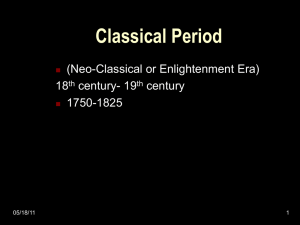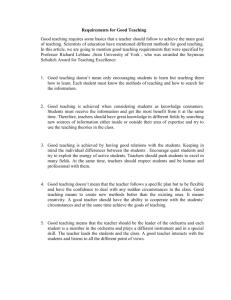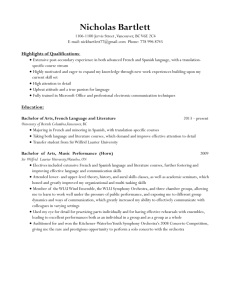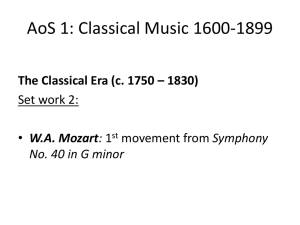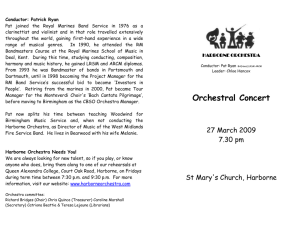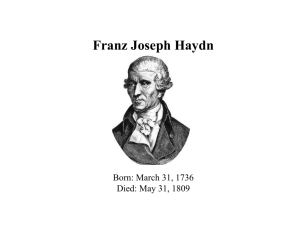get a sneak preview of the programme here
advertisement
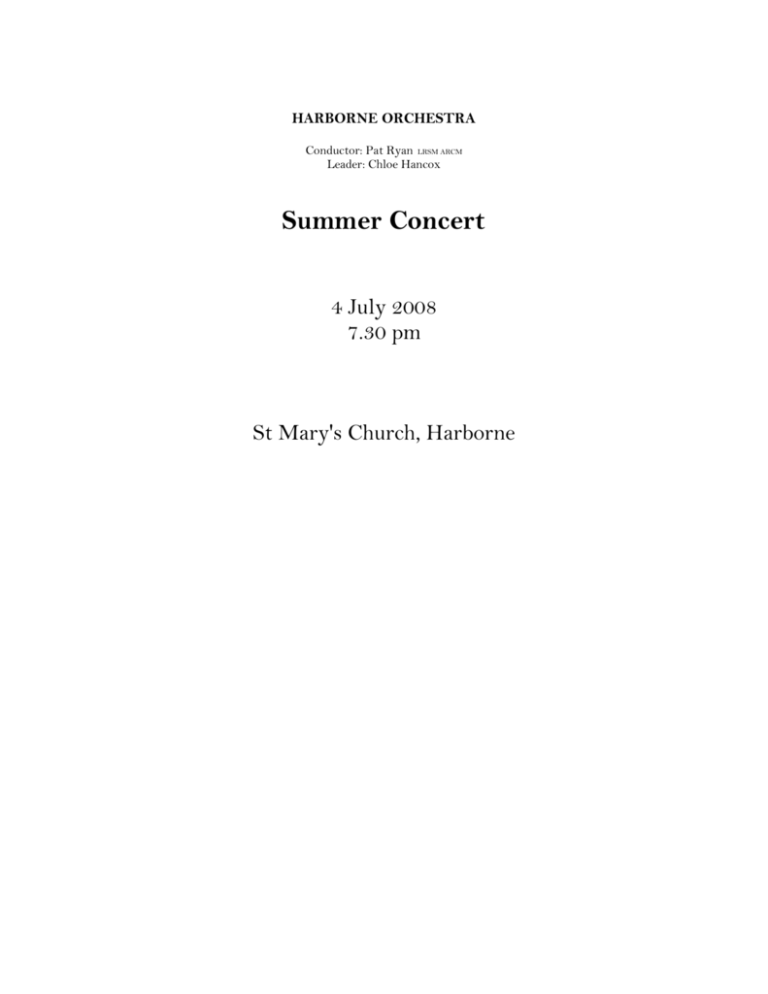
HARBORNE ORCHESTRA Conductor: Pat Ryan LRSM ARCM Leader: Chloe Hancox Summer Concert 4 July 2008 7.30 pm St Mary's Church, Harborne Dear Concertgoer, It is my pleasure to welcome you to this evening’s performance by the Harborne Orchestra. As many of you may know, we are a small but friendly group who enjoy making music in a relaxed and social environment. Our belief is that age or inexperience should not preclude anyone from taking part in music making. Rehearsals take place on Friday nights between 7:30 p.m. and 9:30 p.m. during school term time at the Queen Alexander College, Court Oak Road, Harborne. The orchestra undertakes three concerts a year in the Birmingham area and the occasional extra performance locally. However, we have been invited to perform at a fundraising event in Nottingham in November for NORSACA, the Nottingham Regional Society for Adults & Children with Autism. We very much look forward to supporting this worthwhile charity. I would like to take this opportunity to welcome several new players who have joined us in recent months. The orchestra benefits greatly from their experience and enthusiasm. I hope that they all enjoy the experience and remain members for years to come. We have also benefited from the generosity of Dave Quince at Monitoring and Control Services Ltd, who has once again agreed to sponsor part of this concert. We are very grateful to him and to Chris his bassoonist wife who monitors me every Friday evening and expertly controls the orchestra's finances! Thank you, our audience, for taking the time to support us tonight. I hope that you enjoy the evening. Pat Ryan Conductor: Patrick Ryan Pat joined the Royal Marines Band Service in 1976 as a clarinet and violinist and in that role travelled extensively throughout the world, gaining first-hand experience in a wide range of musical genres. In 1990, he attended the RM Bandmasters Course at the Royal Marines School of Music in Deal, Kent. During this time, studying conducting, composition, harmony and music history, he gained LRSM and ARCM diplomas. From 1993 he was Bandmaster of bands in Portsmouth and Dartmouth, until in 1998 becoming the Project Manager for the RM Band Service’s successful bid to become ‘Investors in People’. Retiring in 2000, Pat became Tour Manager for the Monteverdi Choir's ‘Bach Cantata Pilgrimage’, before moving to Birmingham as the CBSO Orchestra Manager. Pat now splits his time between teaching Woodwind for Birmingham Music Service, as Administrator for Birmingham Early Music Festival and Director of Music of the West Midlands Fire Service Band. He lives in Bearwood with his wife Melanie. Harborne Orchestra Needs You! We are always looking for new talent with which to swell our numbers, so if you play, or perhaps know someone who plays an orchestral instrument, get them to come along to one of our rehearsals. For more information, visit our website: www.harborneorchestra.com Orchestra committee: Richard Bridges (Chair) Chris Quince (Treasurer) Catriona Beattie & Teresa Lejeune (Librarians) Caroline Marshall (Secretary) ……………………………………………………………... Please keep me informed of future concerts by the Harborne Orchestra. (We will not pass on your information to any other organisation.) Name: ……………………………………………………………….. Address: ………………………………………………………………………………………………………………… ………………………………………………………………… Postcode: …………………………………………… E-mail: ………………………………………………….. Telephone: …………………………………………. If you would be interested in supporting the orchestra by helping out at concerts, or leafleting your local area, please tick this box. □ Date for your Diary: The next concert by the Harborne Orchestra is on Friday 5th December 2008 at St Mary’s Church, Bearwood. Programme Don Giovanni Overture Mozart Peer Gynt Suite Number One Grieg 1. Morning 2. The Death of Åse 3. Anitra’s Dance 4. In the Hall of the Mountain King Interval Symphony No. 93 Haydn Harborne Orchestra Programme Notes Don Giovanni Overture Mozart The overture of "Don Giovanni" was written almost on the eve of the first performance, following an alcoholic evening with some friends. One of them reminded him: "Tomorrow the first performance of ‘Don Giovanni’ will take place, and you have not yet composed the overture!" Mozart pretended to get nervous about it and withdrew to his room, where it is said that it took him but three hours to produce this overture. The next evening, a little before the curtain rose, the copyists finished transcribing the parts for the orchestra. Although the musicians had not had time to rehearse the overture, they played it with such precision that the audience broke out into fresh applause. As the curtain rose, Mozart laughingly whispered to the musicians near him: “some notes fell under the stands, but it went well.” The overture consists of an introduction which reproduces the scene of the banquet at which the statue appears. It is followed by an allegro which characterises the impetuous, pleasureseeking Don, who is oblivious to the consequences of his words and actions. Peer Gynt Suite No. 1 Op. 46 Grieg Grieg’s music continues to be relevant in popular culture in the 21st century, due to its similarity in feel to many popular musical genres. This is hardly surprising, since Grieg took many of his melodies from Norwegian folk music. He is quoted as writing, "I am sure my music has the taste of codfish in it." The popularity of his music in modern culture is demonstrated by the vast number of references to it in cartoons, ‘pop’ concerts and television adverts. Suite No. 1 consists of extracted incidental music from the play Peer Gynt, written in 1875 by fellow Norwegian Henrik Ibsen. That first suite was premiered in 1888. Peer Gynt is a colourful character whose high spirits and philandering must inevitably lead to his downfall, unless he is saved by the love of a woman. Morning has often been used in television commercials and motion pictures to depict a sunrise over the countryside. The Death of Åse portrays Peer Gynt, lost in thought as he is seated at the bedside of his dying mother. Anitra’s Dance takes place in the Moroccan desert. Anitra is the daughter of a Bedouin chief whom he loved as a youth. In the Hall of the Mountain King describes the moment when Peking's commence their while to chase after peer Gynt, whose nocturnal activities have led him into the subterranean realms of the Mountain King. - Interval Symphony No. 93 Haydn The D major symphony performed tonight is the one we think of as the first of the now-famous London symphonies. But the chronology of Haydn's symphonies is messy, and the ones we now know as nos. 95 and 96 were actually the first ones he unveiled, shortly after he arrived on New Year's Day 1791. Symphony no. 93 was premiered in February 1792 and was immediately extremely popular with the British public. The Times, which had ignored Haydn's first season in the city, now raved: “Such a combination of excellence was contained in every movement, as inspired all the performers as well as the audience with enthusiastic ardour.” This symphony, suggests that Haydn had taken stock of his London public and was now writing music to satisfy their tastes, challenge their expectations, and even shock them. The opening movement, with its signature slow introduction is particularly impressive, and Haydn proves his originality in the first minute, when he suddenly shifts from D major to the remote harmonies of E-flat major. The main body of the movement is a genial Allegro, featuring a big, showy development section that exhibits both science and charm. The slow second movement begins unexpectedly with a solo string quartet that plays just once and never reappears, and later boasts one of Haydn's most delightfully rude and perfectly timed jokes, courtesy of the bassoon, that is nearly as startling as the famous surprise that gave symphony no. 94 its nickname (“there the ladies will jump,” he said of that one). Haydn's diary tells us that, at the second performance, both the first and second movements were “encored.” The colourful minuet is offset by a trio that alternates loud fanfares and quiet responses to captivating effect. The finale is full of energy and unflagging imagination, right up to the theatrics of its noisy conclusion - an effect not lost on Beethoven in his D major symphony written 11 years later. Musical Anecdotes Three men die, go to heaven and queue to meet St. Peter. St. Peter: Hi, what's your name? Paul: My name is Paul. St. Peter: Tell me, when you died, how much were you earning? Paul: 120K. St. Peter: Wow! What were you doing to earn that kind of money? Paul: I was a lawyer. St. Peter: That's great. Come on in. He turned to the second man. Hi, what's your name? Roger: My name is Roger. St. Peter: Tell me, when you died, how much were you earning? Roger: 60K. St. Peter: Great! What did you do for a living? Roger: I was an accountant. St. Peter: That's very good. Come on in. St. Peter then turned to the third man. Hi, what's your name? John: My name is John. St. Peter: Hi, John. Tell me, John, how much were you earning when you died? John: About 15K. St. Peter: Hey, that's fantastic, John! Tell me, what instrument did you play?
